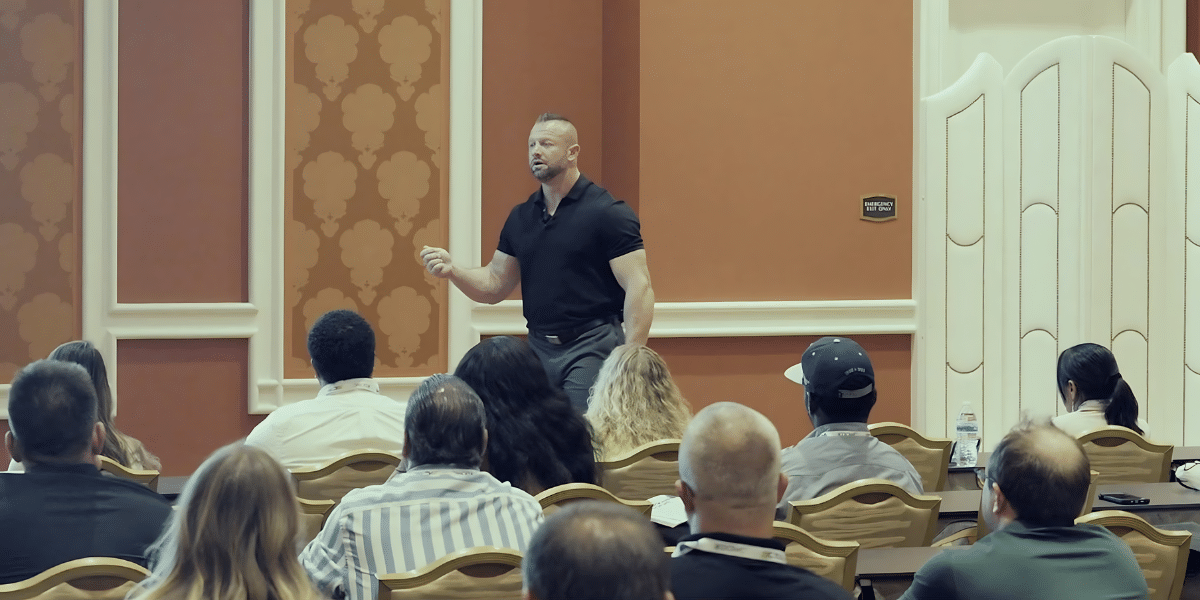By: Sarah Weatherly
In a world where person-to-person interaction is becoming the exception, and social media, text messaging, and AI are the norm, there continues to be one interaction that still requires human intervention: the land of negotiation and persuasion, the world of sales.
This is where former drug addict and bank robber turned millionaire entrepreneur Luke Lunkenheimer finds himself making his home in an effort to change the landscape of selling as one knows it. His new company, Paid 2 Persuade, is not the first of his entrepreneurial ventures. With three successful car dealerships in his trophy case, he is also the visionary CEO behind BARZ, a live video-based rap battle app for smartphones or other connected devices.
According to Lunkenheimer, his heart is in the sale. He finds the rush needed to satiate the dormant volcano of addiction that every recovered addict needs to maintain sobriety and sanity in the thrill of the close. Moreover, he professes that the ability to distill what he has learned into a very simple, very retainable framework, as well as instill confidence in those he teaches, is where he finds enjoyment and meaning in life.

“The other companies,” he says, “They are my devotion to diversification. If one ever forgets how to sell, they must have other irons in the fire,” he says with sarcasm intended. What Lunkenheimer has shared, as of this article, is not only accurate but should serve as a red flag to business owners and salespeople globally. He states, “E-commerce, online fulfillment, and AI have largely taken over in the retail space, but nearly all of these areas were not historically dependent on a salesperson. However, things like buying a car, purchasing a house, and having one’s HVAC system in their home quoted for replacement have always been, and will likely always be, the realm of the salesperson.”
However, it has become overwhelmingly apparent that this landscape has changed in recent years. The consumer is no longer the uneducated prey of the sales floor. In fact, over 80% of salespeople today say their job is harder than ever before due to the level of education the buyer has and the combative stance they are prone to take upon engagement.
The relationship between buyer and salesperson has always been an adversarial one, but in today’s economy, that sentiment echoes louder than ever. So what are salespeople or their managers doing to be proactive and adapt to optimize for the change? Here’s where it gets tricky.
$70 Billion is spent per year on sales training in the United States of America, so apparently, someone in the chain of command knows it is a needed asset. But, according to Luke, virtually all sales training is forgotten after 3 months and the salesperson is right back to where they began, fearing the interaction and the objections to come.
“Today’s sales training is fundamentally flawed,” Luke states (and given the aforementioned statistic, one is inclined to agree). “Meeting a customer, building rapport, lightly qualifying, presenting a product or service and then trial close. Then come the objections. The sales training of yesterday and today is optimized for teaching salespeople how to handle objections. This is how literally all sales training is done today.”
Although many sales training programs have different methods and different frameworks, the overarching themes remain the same as it has been since as early as Dale Carnegie’s days on the sales floor.

“There are methods that include asking in-depth questions at the outset, even optimizing for human behavior (something that Paid 2 Persuade leverages heavily), but even those, which are better but not perfect, still include the inevitability of objections and optimize for objection handling.
Enter the word track. All, that’s right, all sales training that has been the predecessor to Paid 2 Persuade is built around word tracks and objection handling.
“Let’s not get into the proverbial weeds here by naming popular Trainers and companies. P2P teaches unwavering professionalism, and one should practice what they preach. However, if one were to hop onto YouTube, Instagram, Facebook, or Google and begin looking for sales training, there are two or three names that would constantly be shown by the algorithm. These trainers and their companies are creating a “fad” of bombastic social media video shorts, with one-liner word tracks that seem to stump the buyer and force them into a yes. The only problem is they aren’t real. The buyer is an employee or a trainee, the word track is not truly effective, and to any logical onlooker, they know for a fact that this isn’t going to work in the real world.”
The problem, Lunkenheimer shares, is a hopeful sales consultant who is desperately in need of help won’t see the forest for the trees. They will latch onto the entertainment value of the video and seek more engagement with that particular firm because they find themselves subconsciously seeking recreation of the video. They want to sound slick; they want to behave like that, with that level of confidence. They aren’t actually deducing the reality of the situation. Which is number one, those word tracks work about half the time, and number two, they need the level of confidence that a trainer has in order to sound as good or better, and if they are seeking help like this, they don’t have it. Oh yeah, and the video, it wasn’t real in the first place.
So, if everything is so bloody wrong, then how have there been no attempts at intervention before now? How can one trust that this Paid 2 Persuade “discipline” (Lunkenheimer refuses to call it a method, program, or system) is truly the baptism that all salespeople are in such desperate need of? Lunkenheimer encourages salespeople to open their minds to moments in history when the world experienced fundamental change to something that was widely believed to be flawless.
The telephone was “perfect” and did not need improvement until Steve Jobs decided to “fundamentally” change the way people communicated with the introduction of the iPhone. Now, who could fathom life without it? Computers seemed like they could handle any task; everyone who was someone had one, and it was deemed a luxury device, then came the internet. “Remember that one?” Lunkenheimer teases.
Now, all have a computer, and without the internet, one would have forgotten why a computer is even useful if it isn’t online not to mention the vast majority of tasks each day that would come to a screeching halt without it. It is a part of human existence now.
There are plenty of other examples, but anyone who has logical reasoning ability and common sense can now concede after hearing the previous thought that, albeit rare, it is 100% possible that this is, in fact, a needed and necessary change. Furthermore, it suggests that since there has been such a considerable amount of time that has elapsed since any effort at reinventing the process has been proposed, it is highly likely this is an inevitability and absolutely necessary to making economic progress in the USA as well as the world.
Lunkenheimer gave bits and pieces conversationally as to how the Paid 2 Persuade discipline works and how common sales pain points are completely obliterated within the P2P framework. Paid 2 Persuade leverages three major components of the human condition. In fact, the entire training discipline is assembled with high regard to the rule of three, a well-respected and universally understood way that companies assemble data points to be retained by the subject as easily as possible.
Those who have interacted with Lunkenheimer and Paid 2 Persuade all seem to have drawn the same conclusion. Paid 2 Persuade is like nothing that does or has ever existed. It’s relatively simple to learn, requires an individual to have no experience to become effective, and quite frankly, what was impressive was Lunkenheimer’s proven ability to take effective veterans and “tune their knobs,” as he calls it, to make them in some cases realize a 100% increase in commissions. All of this for less than the cost of a week in a decent Vegas hotel seems almost too good to be true.
Lunkenheimer states that the fundamental difference between what exists in the marketplace today (sales training) and what his company offers can be summarized in their 3 C’s. CONFIDENCE, CONTENT, and CADENCE. “One must have confidence,” he says; if the customer recognizes an individual who is not authentic, they are doomed. The trainee needs the game-changing content offered.
“What Paid 2 Persuade brings to the table will be the industry standard within 24-36 months, and there will be no other acceptable way.”
And finally, Cadence. Cadence is a game changer. Remember the wearing-off at three months thing? If the salesperson doesn’t continually engage with the source of the knowledge (The Training), they will inevitably become dull, their selling will suffer greatly, and they will, in fact, lose it after three months. A staunch conclusion can be drawn here. Paid 2 Persuade is the future of sales training, and it’s here to stay. Visit them at www.paid2persuade.com and book an informational call. Paid 2 Persuade is fundamentally changing the game of selling. Don’t get left behind.
Published by: Khy Talara

















